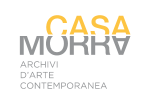Casa Morra
4° anno – 2022 – Gli Unici – DIETER ROTH
Dieter Roth (1930-1998). Tubi, insetti, piatti, giocattoli, objets trouvés, avanzi, sigarette, muffe, formaggio, cacche, vermi e sportine… ciò che è trovato come scarto, come frammento di risulta e come scoria, è per Dieter appetibile e auspicato. Pezzetti di realtà, prelevati dal quotidiano, sono i materiali da costruzione di opere, grandi e piccole, poeticamente sconcertanti. Come in un vecchio cabinet de curiosités il suo spazio mentale è un groviglio di fili elettrici, vecchie radio transistor, monitor, cartine e cioccolata calda. Tutto è accatastato: vernici, disegni, accumuli, pellicole, ruote di bicicletta, tovaglie, utensili… Roth adora i materiali che si deteriorano, le opere fatte per non durare, il lampo di un momento. La vita è in fondo una raccolta di schegge di memoria. Le telecamere, installate in casa durante la sua malattia, riprendono lo scorrere ordinario del tempo mentre lui stesso annaffia le piante, disegna o legge un giornale seduto sul water. Tra salsicce letterarie e tarocchi, Roth si incunea nella malattia-arte. A casa di Rosanna Chiessi, una sera a cena, raccoglie ogni possibile oggetto bidimensionale: cartine, forchette, etichette, foto polaroid (scattate dal commensale Franco Vaccari), pacchetti di MS, disegni accennati e biglietti del treno. “Tutto ciò che è piatto e può essere steso su un foglio”, ha raccontato Vaccari, “è diventato opera”. E tutto è parte della composizione della memoria di quella sera e corre su un filo di 40 metri. È un archivio del momento, una collana di dettagli stesi come le preghiere tibetane sotto la volta del cielo. Il fascino della decomposizione forma, per lui, gli scaffali dell’escrescenza della società borghese.
Manuela Gandini
—
Dieter Roth (1930-1998). For Dieter, pipes, insects, plates, toys, objets trouvés, leftovers, cigarettes, mould, cheese, faeces, worms, sporting goods… whatever he happened upon as waste, debris, slag – all this is highly sought-after and desirable. Fragments of reality from everyday life form the raw materials for poetically disconcerting works of all proportions. As in an old cabinet of curiosities, his mental space is a tangle of electric wires, old transistor radios, monitors, maps, and hot chocolate. Everything is piled high: paint, drawings, accumulations, photographic film, bicycle wheels, tablecloths, tools… Roth loved perishable materials works made to last, the inspiration of a moment. Life is essentially a collection of splinters of memory. Cameras, installed in his home during his illness, record the ordinary flow of time as he waters his plants, draws, or reads a newspaper while sitting on the toilet. Amid literary sausages and tarot cards, Roth becomes wedged in his art-illness. At dinner one evening at Rosanna Chiessi’s house, he gathered up every possible two-dimensional object: maps, forks, labels, Polaroid photos (taken by another dinner-guest, Franco Vaccari), MS packets, rough sketches, train tickets.” “Anything flat that can be spread out on a sheet of paper became a work of art,” said Vaccari. And everything is part of the composition of the memory of that evening: it runs along a 40-metre thread. It is an archive of the moment, a chain of details stretched out like Tibetan prayers offered up to heaven. For him, the fascination of decomposition forms the shelving for the excrescence of bourgeois society.
Manuela Gandini
